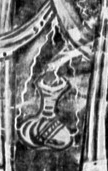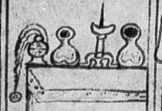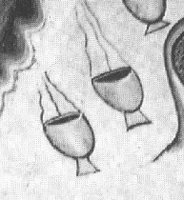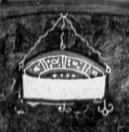Austrian lamps
Several sets of lamps in this manuscript have an unusual shape - baggy rather than tapered at the bottom like this. I guess this shape would work well enough, but the tapered shape works superbly as a hanging lamp (it sort of self balances). The chains the lamps hang from seem to attach near the bottom of the lamp, so I assume they pass under the baggy bits (presumably there are 3 of them) or there is a fastening at the side that we can't see.










(in order) Fol. 13 (2 lamps), Fol. 27, Fol. 37v (3 lamps) Fol. 39, Fol. 56 (2 lamps), Fol.68, Fol.102v. Periscope book, Saint Erentrud Abbey, Salzburg around 1140 (München, Bayerische Staatsbibliothek, Cod. lat. 15903)
And from annother Austrian manuscript: De Laudibus sanctae Crucis, Regensburg c1170/75 (Bayerische Staatsbibliothek, ms. lat. 14159) fol 4v
De Laudibus sanctae Crucis, Regensburg c1170/75 (Bayerische Staatsbibliothek, ms. lat. 14159) fol 4v From the same page, left to right: censer, lamp, candlestick, lamp sitting on an altar in a church.
From the same page, left to right: censer, lamp, candlestick, lamp sitting on an altar in a church.
Now that my preconception about lamps being just one shape is broken, I'm going to do a survey of lamps by geographical location.
Lamps from other places
France Stained Glass window, Chartres Cathedral, 12th C?
Stained Glass window, Chartres Cathedral, 12th C?We can see the chains on the lamp, I'm not sure why there is a bowl below the lamp. (there shouldn't be drips to catch).
Complete picture somewhere on this section of artserv.
England
 copenhagen psalter England, 1175-1200 (Kongelige Bibliotek, MS Thott 143 2º) .f9v
copenhagen psalter England, 1175-1200 (Kongelige Bibliotek, MS Thott 143 2º) .f9vYes, the lamp is hovering in mid air, I assume the artist never got back to draw in the strings.
 winchester psalter Winchester (Priory of St Swithun or Hyde Abbey); between 1121 and 1161(British Library MS Cotton Nero C IV) f10 Nativity.
winchester psalter Winchester (Priory of St Swithun or Hyde Abbey); between 1121 and 1161(British Library MS Cotton Nero C IV) f10 Nativity.St Albans Psalter, St Albans c.1131


 p50. The Three Women at the Sepulchre, p48. The Entombment, p28. The Presentation at the Temple
p50. The Three Women at the Sepulchre, p48. The Entombment, p28. The Presentation at the TempleThe chains on these lamps are drawn as attached to the middle of the body of the lamp, not the top as in the other english examples.

 1160-70 Winchester Morgan Library 619 Scenes from the life of David and SamuelThere appears to be a single chain with a blob on the end hanging down below the lamp. This might be some device to allow lowering of the lamp maybe?
1160-70 Winchester Morgan Library 619 Scenes from the life of David and SamuelThere appears to be a single chain with a blob on the end hanging down below the lamp. This might be some device to allow lowering of the lamp maybe?Italy

 Rome, San Clemente, narthex of the lower church, Miracle at the tomb of St Clement. Wall painting. 1084/1115
Rome, San Clemente, narthex of the lower church, Miracle at the tomb of St Clement. Wall painting. 1084/1115What a lovely shape of lamp. Or it could be some kind of censer I suppose, but why would you have 3 of them? You can also just make out some kind of bar or disc where the chains meet and then attaches to the ceiling with one chain.
Spain


 Santa Maria de Mur, apse, Christ in Majesty. Wall painting. Mid twelfth century(?). Boston, Museum of Fine Arts Spain (Catalonia)
Santa Maria de Mur, apse, Christ in Majesty. Wall painting. Mid twelfth century(?). Boston, Museum of Fine Arts Spain (Catalonia)These ones contrast with the lamps from the st Albans psalter by having their chains attached at the top rim of the lamp.
Conclusion
Send me more examples of 12th C lamps so I can make a better survey. But I can say for now that there are a lot more shapes of lamp above than I expected, even in English examples.
And while we are on the topic of lighting.....
candlesticks
 Periscope book, Saint Erentrud Abbey, Salzburg around 1140 (München, Bayerische Staatsbibliothek, Cod. lat. 15903), fol 49v Doubting Thomas.
Periscope book, Saint Erentrud Abbey, Salzburg around 1140 (München, Bayerische Staatsbibliothek, Cod. lat. 15903), fol 49v Doubting Thomas.Also from the first manuscript, what I think is a candelabra. There is a magnificent 11th C one at St Mary's Cathedral, Hildesheim, Germany. I've seen other Romanseque ones, both islamic and christian, in museum catalogues, and the general design differs little. One interesting thing to note is that the wheel shape was used as frequently for oil lamps as for candles. In fact I find the candles on the hildesheim one suspicious - most 12th C candle holders were of the dish and prong type, not the socket type which was useless without consistent width candles. Some socket shape candle holders developed from socket shaped oil lamp holders, although I'm not sure the hildesheim one is consistent with that either, so maybe it is just an early example of socketed candle holders.
An example candlestick (the prong type):
Samson on a lion, 1st half 13th C, Northern Germany

 Bohemia (?): the guards sleeping at the Sepulchre, from a Gospel Book, MS. Ia folio 49. Late eleventh century. Gniezno Cathedral Library
Bohemia (?): the guards sleeping at the Sepulchre, from a Gospel Book, MS. Ia folio 49. Late eleventh century. Gniezno Cathedral Library
[right]Rome, San Clemente, narthex of the lower church, Miracle at the tomb of St Clement. Wall painting. 1084/1115
The lamps and whole picture (with more identical candlesticks) we have seen above.

 Santa Maria de Tarrasa, apse of the south transept,
Santa Maria de Tarrasa, apse of the south transept,Martyrdom and Apotheosis of St Thomas Becket. Wall painting. c. 1185-1200
Conclusions:
I need more examples of candlesticks too, but this tallys with what I've seen in extant examples (I'll dig out links and post them someday if I find time) - these are all of the prong and dish type, no socket shaped holders here. Note that all the candles are in churches (but only a number of the lamps), which backs up what I've been told about other sources of lighting being more common outside the church. Candles were expensive (especially nice smelling beeswax ones), but important in devotional services (i think that Catholic tradition of lighting a candle is a very old one). In a domestic setting, given the choice of a smelly tallow candle or an olive oil lamp, I know which I'd generally choose.

2 comments:
Have used one of the oil slush bowl lamps at a medieval camping event. This was one of the Viking era iron bowl on a spike (see in front of our tent here).
This was using beef fat drained off a roast from the feast earlier. Fairly nice roast meat smell. Wick was I think cheating and using a commercial woven mesh cotton wick, help in place by wire - have yet to try wool or linen. Burnt well and gave a good light, but possiby not to be trusted in areas with small and/or drunken people facinated by flames. The same event we also experimented with rush lights, made by soaking the pith from mostly pealed locally found rushes in fat. They worked well (unfortunately no photos), but need a better holder than an empty beer can.
Stellar_muddle
I hadn't thought of using beef fat for the fuel. Nice idea.
A few tricks about oil lamps I picked up from Master Bedwyr
is that you can fill the bottom half of oil lamps (olive oil ones at least) with water and they self extinguish and keep the vessel cooler - should be safer than candles. Also that cotton mop head makes a great wick (still cheating, but better) - it's twisted, not the post period braid, it's cheap, and it burns well. I'd like to play with linen sometime though.
And I'd really like to play with rushlights. I'm eagle eyed watching the thin rushes in my garden willing them to get fatter.
Post a Comment